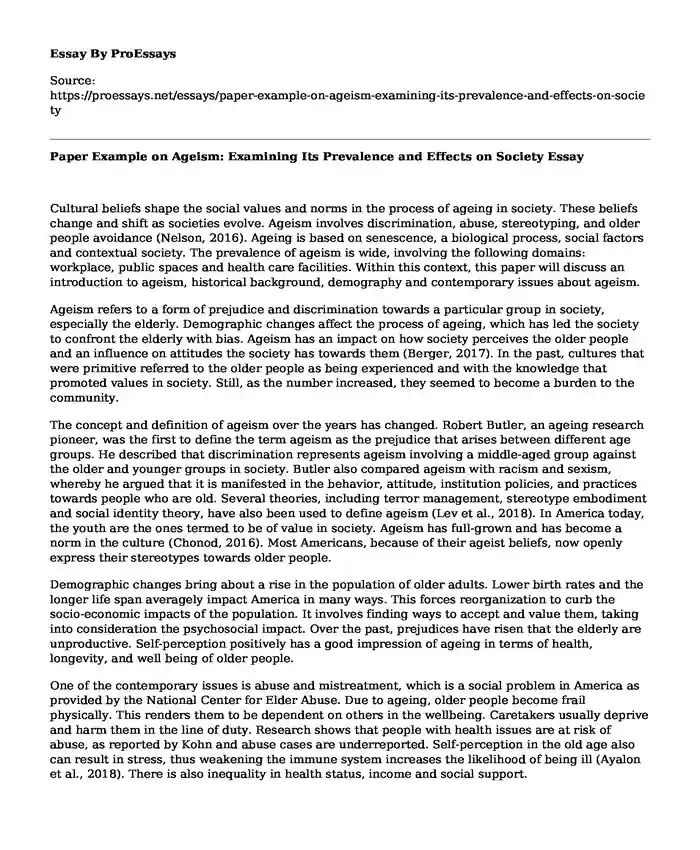Cultural beliefs shape the social values and norms in the process of ageing in society. These beliefs change and shift as societies evolve. Ageism involves discrimination, abuse, stereotyping, and older people avoidance (Nelson, 2016). Ageing is based on senescence, a biological process, social factors and contextual society. The prevalence of ageism is wide, involving the following domains: workplace, public spaces and health care facilities. Within this context, this paper will discuss an introduction to ageism, historical background, demography and contemporary issues about ageism.
Ageism refers to a form of prejudice and discrimination towards a particular group in society, especially the elderly. Demographic changes affect the process of ageing, which has led the society to confront the elderly with bias. Ageism has an impact on how society perceives the older people and an influence on attitudes the society has towards them (Berger, 2017). In the past, cultures that were primitive referred to the older people as being experienced and with the knowledge that promoted values in society. Still, as the number increased, they seemed to become a burden to the community.
The concept and definition of ageism over the years has changed. Robert Butler, an ageing research pioneer, was the first to define the term ageism as the prejudice that arises between different age groups. He described that discrimination represents ageism involving a middle-aged group against the older and younger groups in society. Butler also compared ageism with racism and sexism, whereby he argued that it is manifested in the behavior, attitude, institution policies, and practices towards people who are old. Several theories, including terror management, stereotype embodiment and social identity theory, have also been used to define ageism (Lev et al., 2018). In America today, the youth are the ones termed to be of value in society. Ageism has full-grown and has become a norm in the culture (Chonod, 2016). Most Americans, because of their ageist beliefs, now openly express their stereotypes towards older people.
Demographic changes bring about a rise in the population of older adults. Lower birth rates and the longer life span averagely impact America in many ways. This forces reorganization to curb the socio-economic impacts of the population. It involves finding ways to accept and value them, taking into consideration the psychosocial impact. Over the past, prejudices have risen that the elderly are unproductive. Self-perception positively has a good impression of ageing in terms of health, longevity, and well being of older people.
One of the contemporary issues is abuse and mistreatment, which is a social problem in America as provided by the National Center for Elder Abuse. Due to ageing, older people become frail physically. This renders them to be dependent on others in the wellbeing. Caretakers usually deprive and harm them in the line of duty. Research shows that people with health issues are at risk of abuse, as reported by Kohn and abuse cases are underreported. Self-perception in the old age also can result in stress, thus weakening the immune system increases the likelihood of being ill (Ayalon et al., 2018). There is also inequality in health status, income and social support.
Conclusion
In summary, Ageism is a biological process that all must undergo. Everyone is destined to become old. As it involves discrimination and stereotyping, there have been myths and misconceptions about older people. They are faced with many challenges. Demographic changes make them dependent on society. To curb the stereotyping and discrimination programs should be done on ageism to reduce anxiety in the society, thus help in the taking of the older people with much care and attention.
References
Ayalon, L., & Tesch-Römer, C. (2018). Contemporary perspectives on ageism. Springer Nature.
Berger, R. (2017). Aging in America: ageism and general attitudes toward growing old and the elderly. Open Journal of Social Sciences, 5(08), 183.
Chonody, J. M. (2016). Positive and negative ageism: The role of benevolent and hostile sexism. Affilia, 31(2), 207-218.
Desmette, D., Henry, H., & Agrigoroaei, S. (2019). Ageing in Context: Ageism in Action. The SAGE Handbook of Applied Social Psychology, 323.
Duncan, C. (2017). Ageism, early exit, and the rationality of age-based discrimination (pp. 43-64). London: Routledge.
Lev, S., Wurm, S., & Ayalon, L. (2018). Origins of ageism at the individual level. In Contemporary perspectives on ageism (pp. 51-72). Springer, Cham.
Nelson, T. D. (2016). Ageism.
Cite this page
Paper Example on Ageism: Examining Its Prevalence and Effects on Society. (2023, Sep 30). Retrieved from https://proessays.net/essays/paper-example-on-ageism-examining-its-prevalence-and-effects-on-society
If you are the original author of this essay and no longer wish to have it published on the ProEssays website, please click below to request its removal:
- The Importance of Groups to Christian Leadership Essay
- Essay Sample on Gender Roles
- Cell Phones: Controlling Humans or Humans Controlling Cell Phones? - Essay Sample
- The Digital Youth: Social Media & Adolescence in the 21st Century - Essay Sample
- Paper Example on Mobile Tech: Revolutionizing Communication in Science
- Paper Example on Reviving Professional Culture in Education
- Example on Inequality in Institutions







